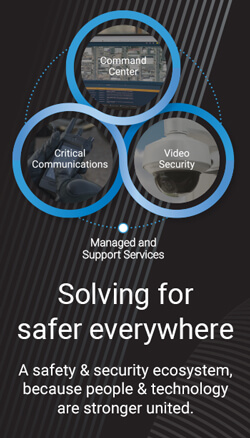IP Video
Wireless CCTV provides many benefits that will take your closed circuit television network to a new level. Access any camera from anywhere on the network with the remote access capability of Wireless CCTV. Place cameras anywhere they are needed, not just where you can run cable to. The flexibility of Wireless CCTV increases the reach and capacity of your closed circuit television network. Manage your budget with ease when you choose Wireless CCTV, and no longer worry about costly power, coaxial cable, and conduit installation.

CCTV - camera surveillance
For decades, CCTV (Closed Circuit Television) was considered an expensive form of surveillance. In fact, CCTV was first only used in industrial process surveillance, where the environment prohibited human presence. Not until CCTV equipment prices began to fall in the 1970s did the technique become more common in traditional security surveillance.
In the last few years, with the advent of smart, computer-enabled surveillance technologies like network video management software, IP (Internet Protocol) use of surveillance systems for security reasons has exploded. Nowadays, IP CCTV surveillance is within economic and technological reach of even the smallest company.
Wireless IP Cameras vs. Wired Analog Cameras
With an analog surveillance camera, the analog video signal is sent through a coaxial cable to a video recorder or monitor. One cable can transport only one video signal from one camera at a time. If you have two cameras, you have to have two cables.
With an Wireless IP-based network camera, the network camera immediately digitizes the images and the video stream is ready to be sent over any computer network available. With a Wireless Broadband System your IP CCTV system can now be put anywhere. Adding cameras is simple as one network cable can easily handle signals from two network cameras simultaneously. In fact, one standard UTP network cable can forward images from more than 220 network cameras simultaneously, without becoming overloaded.
Bridging the technological gap
IP-Surveillance technology offers more cost-efficient, future-proof solutions that bridge the technological gap between the analog and digital worlds. Video servers, for example, can be integrated into an analog CCTV system to digitize analog video sources and distribute digital video over an IP network -- essentially turning analog cameras into network cameras.
A major advantage of using a video server in an analog system is the ability to access real-time video remotely, via an IP network. Live video can be accessed by authorized personnel at any defined workstation on the network, or over the Internet. Additionally, video servers can, using built-in serial ports, control equipment such as Pan/Tilt/Zoom cameras, or special cameras such as super sensitive black/white cameras, miniature cameras and microscope cameras. Furthermore, inputs, such as alarm events, can be used to trigger the server to start transmitting images. Servers equipped with image buffers can also send pre-alarm images.
Camera video server solutions are ideal for sharing high-quality video streams over existing computer networks. Superior to analog video solutions, IP-Surveillance means reliable and distributed access or recording of high-quality digital images, and improved functionality and cost:
- Reduced cabling and installation costs
- Digitization and compression within the network camera/video server
- Embedded Web server for remote access over the LAN/Internet
- Integration with existing analog CCTV systems
- Remote storage, reliable and secure
How is IP carried on a network?
IP really isn't very fussy about how its packets are transported. The details of how an IP packet is carried over a particular kind of network are usually chosen to be convenient for the network itself. As long as the transmitter and receiver observe some convention that allows IP packets to be differentiated from any other data that might be seen by the receiver, then IP can be used to carry data between those stations.
On a LAN, IP is carried in the data portion of the LAN frame and the frame header contains additional information that identifies the frame an an IP frame. Different LAN's have different conventions for carrying that additional information. On an Ethernet the Ethertype field is used; a value of 0x0800 identifies a frame that contains IP data. FDDI and Token Ring use frames that conform to IEEE 802 Logical Link Control, and on those LAN's IP is carried in Unnumbered Information frames with Source and Destination LSAP's of 0xAA and a SNAP header of 00-00-00-08-00.
The only thing that IP cares strongly about is the maximum size of a frame that can be carried on the medium. This controls whether, and to what extent, IP must break down large data packets into a train of smaller packets before arranging for them to be transmitted on the medium. This activity is called "fragmentation" and the resulting smaller and incomplete packets are called "fragments". The final destination is responsible for rebuilding the original IP packet from its fragments, an activity called "fragment reassembly".


